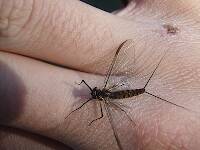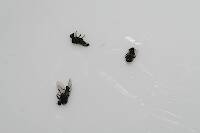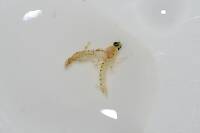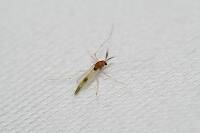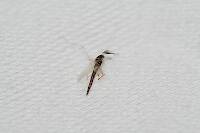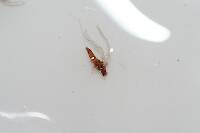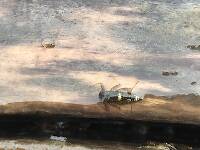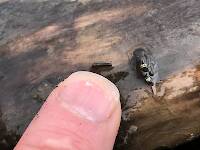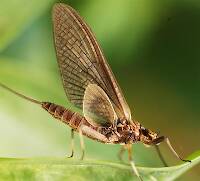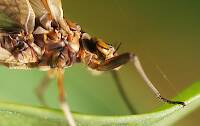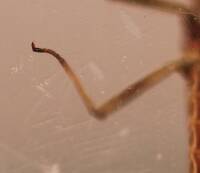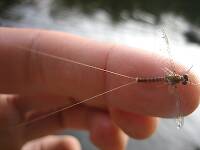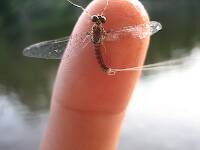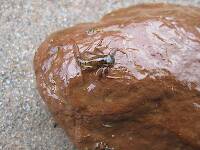
Salmonflies
Pteronarcys californica
The giant Salmonflies of the Western mountains are legendary for their proclivity to elicit consistent dry-fly action and ferocious strikes.
Featured on the forum

Troutnut is a project started in 2003 by salmonid ecologist Jason "Troutnut" Neuswanger to help anglers and
fly tyers unabashedly embrace the entomological side of the sport. Learn more about Troutnut or
support the project for an enhanced experience here.

I'm very tentatively (see the connected forum thread) sticking this mayfly in Rhithrogena for now.
Troutnut on Jun 8, 2007June 8th, 2007, 11:10 am EDT
I didn't even recognize it as a member of that family at first, but it seems to be the only option. The hind tarsus is distinctly 5-segmented, which I verified under the microscope because you can't see it very well on my photos. However, I because it's a female spinner I can't key it to genus using the Merrit & Cummins keys. Does anyone just recognize it?
I found it drifting, nearly dead on the surface at about 5pm on a hot afternoon.
I found it drifting, nearly dead on the surface at about 5pm on a hot afternoon.
Jason Neuswanger, Ph.D.
Troutnut and salmonid ecologist
Troutnut and salmonid ecologist
Konchu on Jun 9, 2007June 9th, 2007, 2:07 am EDT
Ignoring all other details, the body shape & color and leg markings resemble some Epeorus and Rhithrogena. Possibly Rhithrogena is the closest. I collected some about like this with male spinners a few weeks ago in Tennessee.
Troutnut on Jun 9, 2007June 9th, 2007, 4:16 am EDT
I was considering Rhithrogena too because it has a few of those anastomosed crossveins. They just aren't as prominent as I've seen in most illustrations, which gave me cause for doubt. I'll tentatively stick it in there for now.
Jason Neuswanger, Ph.D.
Troutnut and salmonid ecologist
Troutnut and salmonid ecologist
Tana on Jan 31, 2009January 31st, 2009, 9:15 pm EST
Hola, Creo que no es posible determinar un insecto de estas caracteristicas en esste estado, ha tantos tipos de Rhithrogena que no podria saber si realmente es alguna, en estados adultos yo en España recomiendo imitar color y tamaño, a mi me parece que se puede sustituir por la March Bronw, recomiendo leer esto:
http://images.google.es/imgres?imgurl=http://www.cpdrioarga.com/prueba/naturaleza/moscasnaturales/efemeras/heptagenidos/imagenes/heptagenido%2520(subimago)%2520hembra%25202.jpg&imgrefurl=http://www.cpdrioarga.com/prueba/naturaleza/moscasnaturales/efemeras/heptagenidos/heptagenidos.html&usg=__99R-yRByWLBw2Ny4WA5Ygf_8yjs=&h=450&w=600&sz=55&hl=es&start=67&um=1&tbnid=J0oT_Bxb0Cv5xM:&tbnh=101&tbnw=135&prev=/images%3Fq%3DRhithrogena%26start%3D54%26ndsp%3D18%26um%3D1%26hl%3Des%26lr%3Dlang_es%26rlz%3D1T4HPEB_esES305ES305%26sa%3DN
Un saludo a todos Tana
http://images.google.es/imgres?imgurl=http://www.cpdrioarga.com/prueba/naturaleza/moscasnaturales/efemeras/heptagenidos/imagenes/heptagenido%2520(subimago)%2520hembra%25202.jpg&imgrefurl=http://www.cpdrioarga.com/prueba/naturaleza/moscasnaturales/efemeras/heptagenidos/heptagenidos.html&usg=__99R-yRByWLBw2Ny4WA5Ygf_8yjs=&h=450&w=600&sz=55&hl=es&start=67&um=1&tbnid=J0oT_Bxb0Cv5xM:&tbnh=101&tbnw=135&prev=/images%3Fq%3DRhithrogena%26start%3D54%26ndsp%3D18%26um%3D1%26hl%3Des%26lr%3Dlang_es%26rlz%3D1T4HPEB_esES305ES305%26sa%3DN
Un saludo a todos Tana
Taxon on Feb 1, 2009February 1st, 2009, 6:24 am EST
Although the translation may be less than perfect,
this is (more or less) what Tana is saying
when translated to English:
this is (more or less) what Tana is saying
when translated to English:
Hello, I think it is not possible to identify an insect of its kind in this state,
has many different types of Rhithrogena could not really tell if any,
adult I recommend imitate Spain in color and size,
I find that you can replaced by the March Brown,
I read this:
Greetings,
Tana
Quick Reply
Related Discussions
Topic
Replies
Last Reply
3
Jul 5, 2017
by Crepuscular
by Crepuscular
4
Apr 10, 2020
by Konchu
by Konchu
Re: Puzzled on this mayfly, not even confident on family
In Male Rhithrogena hageni Mayfly Spinner by Troutnut
In Male Rhithrogena hageni Mayfly Spinner by Troutnut
1
Jul 23, 2019
by Millcreek
by Millcreek






